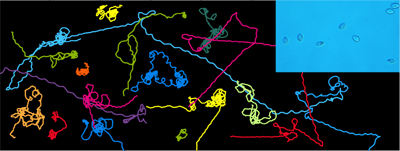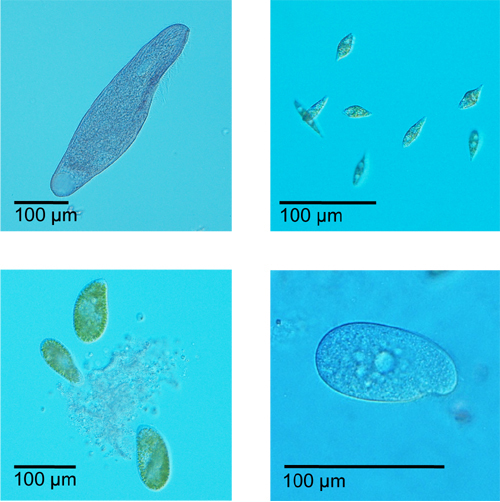Scaling in Ecosystems and Biological Dispersal

Swimming trajectories of a protist species (protist picture: courtesy of Regula Illi and Florian Altermatt, Eawag).
We are interested in scaling laws in ecology, with a focus on allometric scaling laws, where the mass of organisms is the independent variable. Body size, in fact,is a key quantity in ecology as it matters for organisms’ metabolic, growth, mortality and other vital rates. We study the sca
ling properties of intra- and interspecific distributions of body size and their robustness to biotic and abiotic forcings, through reproducible laboratory experiments with protists/algae microcosms. Ecological scaling laws such as the species-area relationship (the number of species living in an ecosystems was shown to scale with its area) have been widely and successfully used to predict extinctions due to habitat reduction. Apart from an academic interest on the laws that govern ecosystems, therefore, scaling laws can serve as tool for ecosystems’ management, e.g., conservation biology. Moreover, protists and unicellular algae are of key ecological significance. In fact, they are the basic food source of almost all aquatic food-webs, and unicellular algae are responsible for nearly 50% of the worldwide biomass production. As shifts in these communities can have major global consequences, it is of fundamental importance to understand the mechanisms that regulate their abundance, size distribution and robustness to biotic and abiotic forcings.
 We study how species disperse, i.e., their active movement and reproduction. We are interested in testing the predictions of reaction-diffusion processes by performing microcosms experiments with protist species. We link the microscopic dynamics (the active movements of organisms) to dispersal patterns at the broader scale. Moreover, we want to understand how species interactions (competition, predation) and spatial structures, especially river-networks, can affect dispersal from both a theoretical and an experimental perspective. The aim is to understand the dynamics of invasive species or disease propagules in river networks and to predict wether species can keep up with the shifts in their ranges which are induced by changing climate conditions.
We study how species disperse, i.e., their active movement and reproduction. We are interested in testing the predictions of reaction-diffusion processes by performing microcosms experiments with protist species. We link the microscopic dynamics (the active movements of organisms) to dispersal patterns at the broader scale. Moreover, we want to understand how species interactions (competition, predation) and spatial structures, especially river-networks, can affect dispersal from both a theoretical and an experimental perspective. The aim is to understand the dynamics of invasive species or disease propagules in river networks and to predict wether species can keep up with the shifts in their ranges which are induced by changing climate conditions.
Contact person(s) :  PhD: A. Giometto,
PhD: A. Giometto,  PhD: S. Zaoli,
PhD: S. Zaoli, Prof. A. Rinaldo,
Prof. A. Rinaldo,
